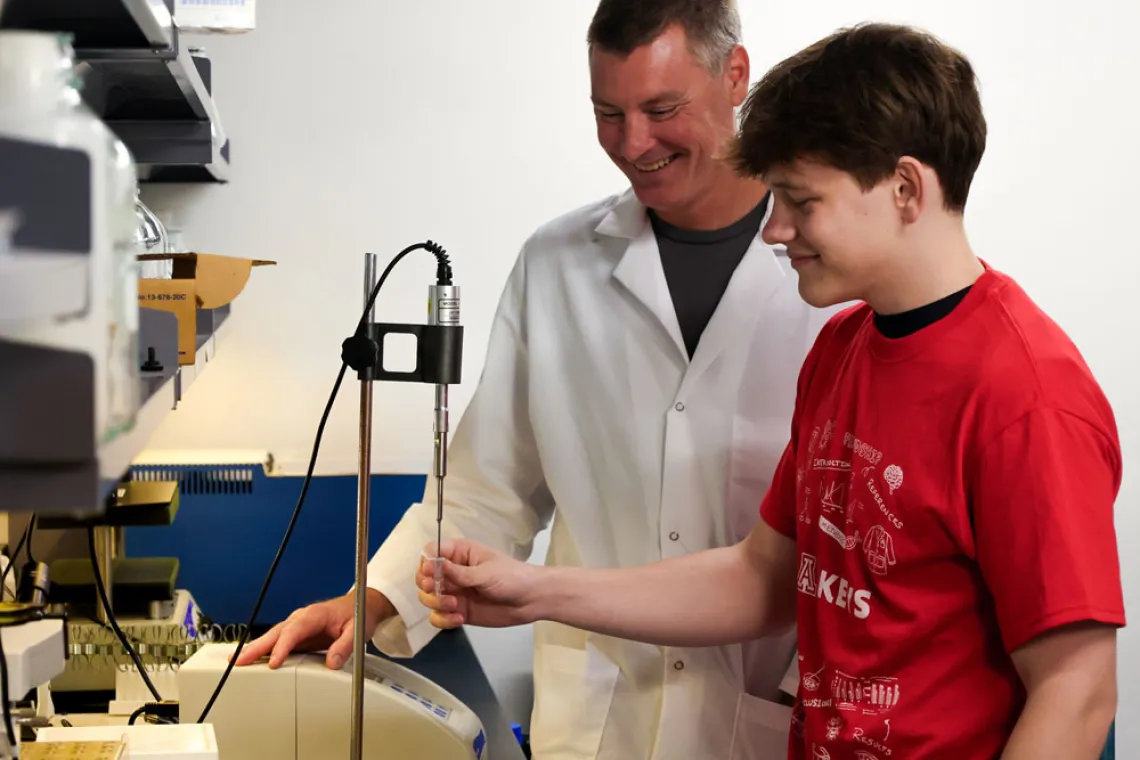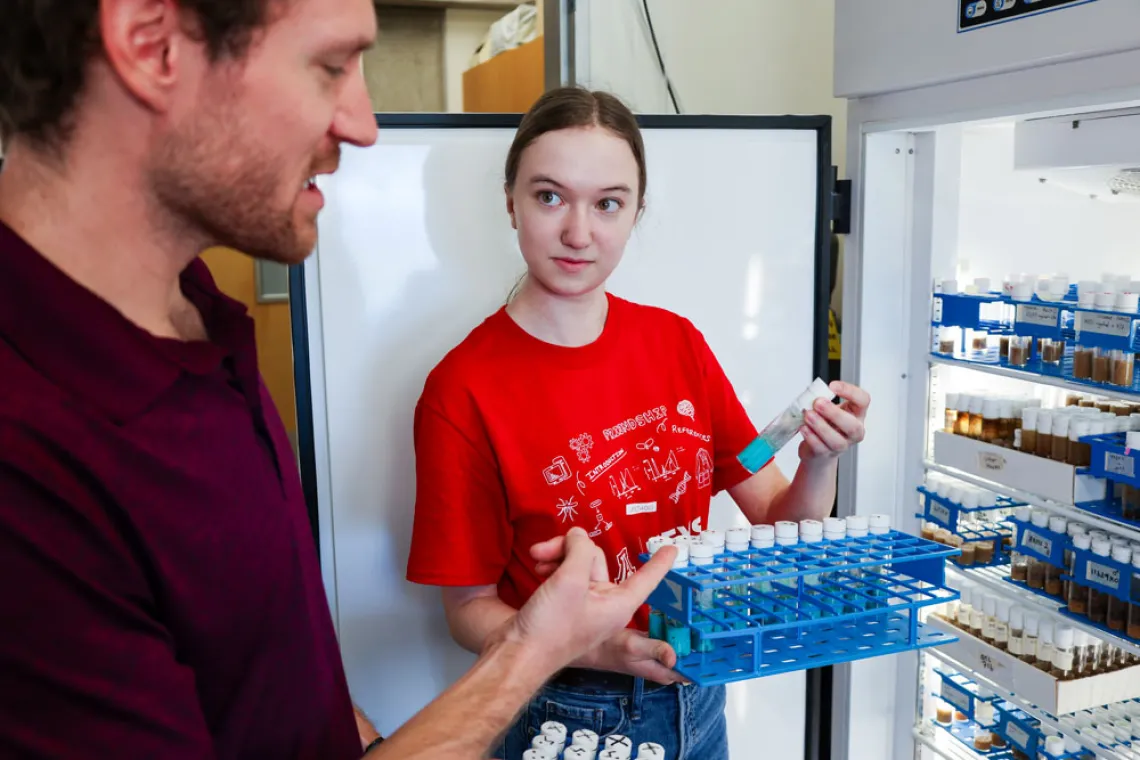Peer in the labs, microscopes, and computers of our 2024 high school interns
See examples of University of Arizona research projects during the KEYS Research Internship that trains the next generation of innovators.

2024 KEYS intern Sonia Swaroop (left) works with one of her mentors Lisa Shanks (right) on genetically engineered models at the BIO5 Institute.
This year, 59 interns committed seven weeks of their summer to the BIO5 Institute’s Keep Engaging Youth in Science (KEYS).
Under the mentorship of over 50 University of Arizona researchers and their labs, their experiences covered various scientific disciplines and included rigorous training, hands-on and virtual projects, data analysis, and computational modeling. Interns had the unique opportunity to contribute to ongoing research such as cancer biology, neurodegenerative and cardiac diseases, biomedical engineering, environmental and insect science, and physics.
Including this year’s class, 746 interns have completed the KEYS and gone onto successful STEM careers.
Learn more about specific projects and how this U of A internship helps these aspiring scientists reach their goals.
Understanding and treating chronic pain
Despite migraines affecting millions of people, especially women, there is no universal treatment for this neurological disorder.
A promising lead for understanding migraines is studying the endogenous cannabinoid system (ECS), a focus for the lab of Tally Largent-Milnes, an associate professor of pharmacology in the University of Arizona College of Medicine – Tucson and BIO5 member.

2024 KEYS intern Jishnu Nayak (center) from Arizona College Preparatory High School is working in the lab of Tally Largent-Milnes (left), mentored by research technician Anya Burtman (right).
The ECS is a highly specialized messaging network in the human body. Messengers (cannabinoids) travel to different parts of a bustling city (your body) to deliver important messages that keep the city functioning smoothly. However, when these naturally occurring cannabinoids are out of balance, it disrupts mood, pain sensation, appetite, and memory. With their research showing lower levels of endocannabinoids in females, the Largent-Milnes lab is focused on creating drugs that could help with migraines and other chronic pain.
“We don’t know the underlying processes of migraine, and that’s why this lab exists,” said Anya Burtman, a research technician, and KEYS mentor. “We’re currently diving deeper into how females and males react to anti-migraine medication dosages, relating it back to the endocannabinoid system.”
2024 KEYS intern Jishnu Nayak (he/him) from Arizona College Preparatory High School is working with Burtman in the lab to set up experiments and learn more about the molecular components of the migraine.
“I’m thinking about becoming a physician because I want to help people,” said Nayak. “Since medical misinformation is a big problem, I want to be able to convey research to people without a scientific background.”
Analyzing bat data to study brains
To say that how the brain collects information from the environment is complicated is an understatement. Take driving a car around a city — the brain must simultaneously react to its surroundings while also focusing on taking the correct route.
That’s where echolocating bats come in. In order to study how a brain accomplishes sensory-driven actions, the lab of Melville Wohlgemuth, an assistant professor of neuroscience in the University of Arizona College of Science and BIO5 member, uses motion capture technology and microphones to study bats’ natural hunting behaviors as a model for how humans find their way in the world.

Virtual 2024 KEYS intern Vinay Ramasamy Sathis Babu (center, on computer) from Hamilton High School is being mentored by Melville Wohlgemuth (second from left).
“One of the most important changes a bat makes to its sonar behaviors is modifying the way it vocalizes, such as increasing the rate of vocalization to gain more information about the world around it,” said Wohlgemuth, KEYS mentor. “My KEYS intern is looking at the change in vocalization, specifically the rate of vocalization when they are hunting in open and cluttered environments.
Virtual 2024 KEYS intern Vinay Ramasamy Sathis Babu (he/him) from Hamilton High School is focused on examining motion capture and audio data from the past few years to better understand how a bat changes its behavior in a cluttered versus uncluttered environment.
“I’ve always been a curious person,” said Babu. “This opportunity has taught many new skills, from time management to learning new software and analyzing data, and makes me excited to continue with research.”
Creating genetic models to study disease
To answer very specific genetic questions about diseases, researchers need very specific models.
That’s where the genetically engineered model core at the BIO5 Institute comes in. Teodora Georgieva, director of the GEMM Core and BIO5 member, and her team develop in vivo and in vitro models for University of Arizona researchers as well as for researchers across the United States and Europe.

2024 KEYS intern Sonia Swaroop (left) from Paradise Valley High School is being mentored by Teodora Georgieva (right).
“We create models so researchers can study the function of genes and their proteins, or replicate human diseases,” said Georgieva, a KEYS mentor along with her staff scientist Lisa Shanks. “This is an important step in providing scientists with tools to study diseases and find potential therapeutics to cure them.”
2024 KEYS intern Sonia Swaroop (she/her) from Paradise Valley High School has been working on different ways to deliver CRISPR-Cas9, a genome editing tool, into cell lines to improve the production of their models. She’s also stepped up and taken responsibility for various cell cultures critical to the core.
“I want to attend medical school and become a trauma surgeon,” said Swaroop. “It’s important for me to learn more about the biology of the human body.”
Examining obesity at a cellular level
Obesity affects nearly two-thirds of Americans and is linked to high blood pressure, insulin resistance, and increased risk of developing cancer.
The lab of Benjamin Renquist, associate professor of animal and comparative biomedical sciences in the University of Arizona College of Agriculture, Life & Environmental Sciences and BIO5 member, studies how obesity alters communication between organs that can cause hypertension and insulin resistance.

2024 KEYS intern Thomas Benson (right) from American International School Chennai is being mentored by Benjamin Renquist (left).
His lab specifically focuses on the role of the peripheral nervous system in communicating signals from a fatty liver to the blood vessels in the body, called the vasculature.
“Our lab has previously shown that fatty liver causes an increased release of the inhibitory neurotransmitter gamma aminobutyric acid, GABA for short,” said Renquist, a KEYS mentor. “Our KEYS intern Thomas is working to understand the role of liver endothelial cells in the release of this neurotransmitter.”
2024 KEYS intern Thomas Benson (he/him) from American International School Chennai conducted studies aimed at identifying the liver cell type that produces GABA, showing that activating receptors that are only expressed on the cells that line blood vessels (endothelial cells) stimulates GABA release.
“I’m interested in veterinary science,” said Benson. “I want to better understand the science behind animal behavior and functions in order to help animals.”
Studying the genomics of adaptation
How does an organism and its species change over time? Is it a function of genetics, environment, or both?
Those are fundamental questions driving the ecological and evolutionary genomics research in the lab of Luciano Matzkin, associate professor of entomology in the University of Arizona College of Agriculture, Life & Environmental Sciences and BIO5 member.

2024 KEYS intern Lucy Waddell (right) from Ironwood Ridge High School is being mentored by postdoctoral researcher Andrew Legan (left) in the lab of Luciano Matzkin.
The Matzkin lab focuses on cactophilic Drosophila, small flies that inhabit the deserts of North America and specialize in eating rotten cacti. Drosophila are model organisms — they breed quickly and have easily manipulable genetics — and the Matzkin lab uses them to better understand how insects evolve to interact with chemicals in their environment.
“Everyone in our lab works on questions around insect molecular evolution,” said Andrew Legan, postdoctoral researcher and KEYS mentor. “For her project, our KEYS intern is investigating how cactophilic Drosophila detect and respond to threats in their environment.”
2024 KEYS intern Lucy Waddell (she/her) from Ironwood Ridge High School is studying how flies might use their sense of smell to respond to parasitic mites.
“I want to pursue a science degree in college,” said Waddell. “I’ve learned a lot about all the effort that goes into a research project, like how to raise fruit flies!”
Unraveling cell function to understand cancer
Peering into the basic structure and function of biomolecules can lead to breakthroughs in understanding disease.
A piece of that is studying the transcriptional regulation of RNA binding proteins, referring to the processes that control the production of proteins in the cell. That’s the focus of the lab of Jacob C. Schwartz, associate research professor in pharmacology at the University of Arizona College of Medicine - Tucson and BIO5 member.

2024 KEYS intern Benite Luhando (right) from Sahuaro High School is being mentored by doctoral student Ajibola D. Adelakun (left) in the lab of Jacob C. Schwartz.
Transcriptional regulation involves a complex system of signals and molecules that determine when and how much of these proteins should be produced. Understanding this production process is vital for normal cell function and can also be relevant in diseases where RNA regulation is disrupted.
“We are studying transcriptional regulation using cell based assays,” said Ajibola D. Adelakun, a doctoral student in pharmaceutical sciences and KEYS mentor. “One example is looking at a specific long noncoding RNA that regulates gene expression and is involved in cancer development and progression.”
2024 KEYS intern Benite Luhando (she/her) from Sahuaro High School is studying this long noncoding RNA to better understand Ewing sarcoma, the second most common pediatric bone cancer, at a molecular and cellular level.
“I will be attending the University of Arizona this fall and I want to continue to pursue research,” said Luhando. “I want to contribute to the world by working on solving small pieces of a big problem.”
Imaging blood vessels to study Alzheimer’s disease
Neurodegenerative diseases affect the blood vessels in the brain, potentially creating a cascading effect that could hasten the progression of dementia, Alzheimer’s disease, and other diseases associated commonly with aging.
In the lab of Paulo Pires, assistant professor in physiology at the University of Arizona College of Medicine - Tucson and BIO5 member, their mission is to come up with new therapies for neurodegenerative diseases by studying the brain vasculature.

2024 KEYS intern Darren Yong (left) from University High School is being mentored by Paulo Pires (right).
One avenue is examining the effect of these diseases on cell communication in the brain, potentially influencing the size of blood vessels and how much blood reaches the brain.
“We’re working on a new project that is testing one particular ion channel located in the lysosomes, a membrane-bound organelle that contains digestive enzymes inside cells,” said Pires, a KEYS mentor. “Our KEYS intern is conducting initial experiments to see if this ion channel is affected by Alzheimer’s disease.”
2024 KEYS intern Darren Yong (he/him) from University High School is working on imaging in a dark room, adding a chemical to the blood vessels and examining them underneath a microscope.
“I wanted to work in this lab because I’m interested in neuroscience,” said Young. “I’m most excited to analyze my data and look at the results.”

